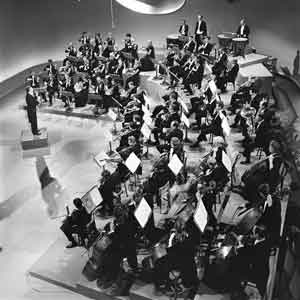THE NATIONAL SYMPHONY ORCHESTRA AT 75
Published in Issue 2 (March/April 2023), News, Volume 31By Richard Pine
The orchestra which this year celebrates its 75th anniversary as the National Symphony Orchestra was officially launched in 1948 as the Radio Éireann Symphony Orchestra (RÉSO) and, from 1966, the RTÉSO. Later still, it was repositioned as ‘the RTÉ National Symphony Orchestra’. And thereby hangs a long story.
Like many European states at the outset of public service broadcasting, Ireland, through its national broadcaster, 2RN, established a nucleus of classical performers from the late 1920s onwards. And, like many other European states, it debated with itself whether to promulgate its indigenous music in parallel with ‘classical’ music in the Western genre. Until its separation from the civil service, Radio Éireann was the child of the then Department of Posts and Telegraphs, where civil servants such as P.S. O’Hegarty and León Ó Broin sought to persuade their often strongly nationalistic political masters of the rationale for classical music.
For example, James Everett, as minister for Posts and Telegraphs in 1948–51—the crucial period for the emergence of the orchestra—supported his staff in all respects yet privately despised classical music. In opposition he went on record that it would be ‘torture’ to listen to it, saying that it was ‘for the benefit of a few old fogies in Rathmines’ (Dáil Reports 142, 10 November 1953). He was trenchantly opposed to the employment in the orchestra of foreigners (whose expertise was a vital ingredient in its establishment). In this he was supported by Liam Cosgrave, who told the Dáil that, while he wanted the best orchestra available, it should be composed of Irish players (Dáil Reports 134, 5 November 1952). This was impossible, since the training of musicians in Ireland at that time was negligible, and the recruitment of foreign players not only was inevitable but also provided a Continental flavour to the orchestra’s acoustic, which it has never lost. Important accretions of foreign musicianship came at the outset, in 1947–8, and with a defection of players from East Germany in 1953 (in which Fachtna Ó hAnnracháin, as music director, was enthusiastically supported by his minister, Erskine Childers) and later with the Hungarian upheavals of 1956.
The appointment of women was also a matter of debate, since women in the civil service were required to resign on marriage. In 1932 it was stated that the minister for Finance ‘feels that the appointment of married women is not desirable’ (H.P. Boland, secretary of the Department of Finance, to Posts and Telegraphs, 2 November 1932), but he had to concede not only that it might be necessary to appoint married women to the orchestra but also that they should not be required to resign upon marriage. Nevertheless, the resignation rule remained in force until at least 1962.
With RTÉ the only provider of symphonic music, Ireland was almost unique in having no other orchestra of national status, but whether the ‘national broadcaster’ should necessarily bear the huge financial cost was an extra irritant in the equation of national pride. In 1961 Radio Éireann asked George Willoughby, the BBC’s concerts manager, to assess the status of the orchestra. Willoughby advised that it should be repositioned as the ‘National Orchestra of Ireland’; it took until 1989 to implement his recommendation.
Nevertheless, the argument that what was, in effect, Ireland’s national orchestra should have its own autonomous identity, with appropriate State support, gathered momentum. In 1994 then Minister for Arts Michael D. Higgins established a review group, ‘PIANO’ (Provision and Institutional Arrangements Now for Orchestras and Ensembles), which attempted, unsuccessfully, to distinguish between the RTÉSO’s broadcasting and non-broadcasting functions, since public concert-giving, support for the opera seasons in Dublin, Cork and Wexford and international touring were becoming an excessive financial burden on an organisation whose principal responsibility was radio and television broadcasting. The cost of the RTÉ NSO then was ₤2.75m; today it is €8m. The PIANO report recommended that the NSO should be re-established by legislation, but this fell by the wayside with the collapse of the Coalition government the following year.
Finally, in 2018 Helen Boaden, former head of BBC Radio, was commissioned to undertake a similar function. She concluded that the orchestra should either be established as a separate State body or be absorbed into the National Concert Hall, where the orchestra has lived since the opening of the NCH in 1981. This would make the NCH’s ‘ownership’ of the NSO a natural step and was recognised as such in the government’s decision in 2018.
What is indisputable is that the National Symphony Orchestra has, for the past 75 years, been the backbone of the classical music experience in Ireland, with orchestral members, soloists and conductors both Irish and foreign. In addition to its routine concert-giving, it has often achieved international heights of music-making. It has survived despite—and sometimes because of—the political, financial and administrative minefields of culture.
Richard Pine is the author of 2RN and the origins of Irish radio (2002) and Music and broadcasting in Ireland (2005).

















